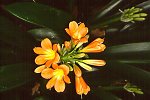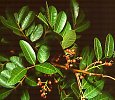|
Poisonous plants of southern Africa
Most of the information below is from Munday (1988)
|
Amaranthaceae
(Pigweed family)
Species of Amaranthus are cultivated and the
leaves cooked like spinach ('morogo') and they also often occur as weeds.
They become poisonous if grown on nutrient rich soils (e.g. on compost
heaps and in heavily fertilised soil) because under these conditions they
accumulate dangerous levels of oxalates. |
|
|
Amaryllidaceae (Nerine,
Clivia, March Lily, Snowdrop, Dafoddil family)
Many species in the Amaryllidaceae have bulbs that
contain toxic alkaloids. Other parts of the plant can also be poisonous.
For instance, all parts of Clivia
miniata are toxic and the leaves of daffodils and jonquils if
eaten can cause vomiting and diarrhoea. See list of important
poisonous species |

|
|
Anacardiaceae
(Mango, Cashew Nut, Rhus family)
Most of the harmful species in this family affect us
through the sap causing a severe allergic reaction to the skin (e.g. shell
of Cashew Nuts;
sap of Poison Ivy, African
Poison Ivy, Smoke
Tree, Japanese Wax Tree
and Mango). Fruit of pepper
trees can be toxic if eaten in quantity. Your kidneys can become
inflamed if you eat too many mangoes.
See list of important poisonous species.
|
 |
|
Apiaceae
(Carrot family) |
|
Publications
-
Munday, J. 1988. Poisonous Plants in South
African Gardens and Parks. A Field Guide. Delta Books, Craighall,
Johannesburg.
|
